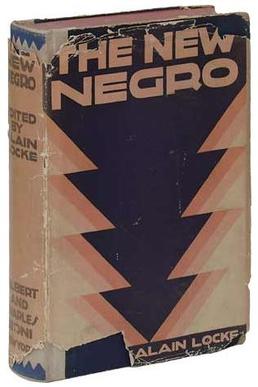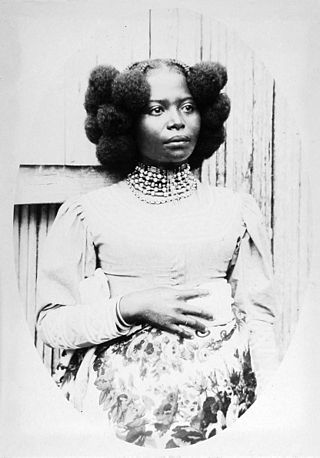Related Research Articles

Dreadlocks, also known as dreads or locs, are a hairstyle made of rope-like strands of hair. This is done by not combing the hair and allowing it to mat naturally or by twisting it manually. Over time, the hair will form tight braids or ringlets.

The afro is a hair style created by combing out natural growth of afro-textured hair, or specifically styled with chemical curling products by individuals with naturally curly or straight hair. The hairstyle can be created by combing the hair away from the scalp, dispersing a distinctive curl pattern, and forming the hair into a rounded shape, much like a cloud or puff ball.
African-American culture, also known as Black American culture or Black culture in American English, refers to the cultural expressions of African Americans, either as part of or distinct from mainstream American culture. African-American culture has been influential on American and global worldwide culture as a whole.

Anna Marie Wooldridge, known professionally as Abbey Lincoln, was an American jazz vocalist. She was a civil rights activist beginning in the 1960s. Lincoln made a career out of delivering deeply felt presentations of standards as well as writing and singing her own material.

The New Negro: An Interpretation (1925) is an anthology of fiction, poetry, and essays on African and African-American art and literature edited by Alain Locke, who lived in Washington, DC, and taught at Howard University during the Harlem Renaissance. As a collection of the creative efforts coming out of the burgeoning New Negro Movement or Harlem Renaissance, the book is considered by literary scholars and critics to be the definitive text of the movement. Part 1 of The New Negro: An Interpretation, titled "The Negro Renaissance", includes Locke's title essay "The New Negro", as well as nonfiction essays, poetry, and fiction by writers including Countee Cullen, Langston Hughes, Zora Neale Hurston, Claude McKay, Jean Toomer, and Eric Walrond.
Black pride is a movement which encourages black people to celebrate their respective cultures and embrace their African heritage.
Black is beautiful is a cultural movement that was started in the United States in the 1960s by African Americans. It later spread beyond the United States, most prominently in the writings of the Black Consciousness Movement of Steve Biko in South Africa. Black is beautiful got its roots from the Négritude movement of the 1930s. Negritude argued for the importance of a Pan-African racial identity among people of African descent worldwide.

Kinky hair, also known as afro-textured hair, is a human hair texture prevalent in the indigenous populations of many regions with hot climates, mainly sub-Saharan Africa, some areas of Melanesia, and Australia. Each strand of this hair type grows in a repeating pattern of small contiguous kinks. These numerous kinks make kinky hair appear denser than straight, wavy, and curly hair types.
Black power is a political slogan and a name which is given to various associated ideologies which aim to achieve self-determination for black people. It is primarily, but not exclusively, used by black activists and other proponents of what the slogan entails in the United States. The black power movement was prominent in the late 1960s and early 1970s, emphasizing racial pride and the creation of black political and cultural institutions to nurture, promote and advance what was seen by proponents of the movement as being the collective interests and values of black Americans.

African-American hair or Black hair refers to hair types, textures, and styles that are linked to African-American culture, often drawing inspiration from African hair culture. It plays a major role in the identity and politics of Black culture in the United States and across the diaspora. African-American hair often has a kinky hairy texture, appearing tightly coiled and packed. Black hair has a complex history, culture, and cultural impact, including its relationship with racism.
The feminine beauty ideal is a specific set of beauty standards regarding traits that are ingrained in women throughout their lives and from a young age to increase their perceived physical attractiveness. It is experienced by many women in the world, though the traits change over time and vary in country and culture.
Discrimination based on hair texture, also known as textureism, is a form of social injustice, where afro-textured hair or coarse hair types, and their associated hair styles, are viewed negatively, often perceived as "unprofessional", "unattractive", or "unclean". This view can lead, for example, to some school students being excluded from class.
Cecil Elombe Brath was a Pan-African activist, born in New York City of Barbadian heritage, who is best known for founding the Patrice Lumumba Coalition. He was an influential activist, recognized by Stokely Carmichael as the "Dean of Harlem Nationalists" and by Dudley Thompson, an "Icon of the Pan-African Movement".
The natural hair movement is a movement which aims to encourage people of African descent to embrace their natural, afro-textured hair; especially in the workplace. It originated in the United States during the 1960s, and resurged in popularity in the 2000s.
George Edward Tait was an American poet, writer, educator, storyteller, journalist, activist, historian, public speaker, tutor, bandleader, musician, and performer. He was known as the Poet Laureate of Harlem, and a part of the Black Arts Movement. He was the author of At Arms and The Baker's Dozen: Selected Dance Poems. He spearheaded a musical poetry group called Black Massical Music from 1972 to 1977. He founded The Society of Afrikan Poets. His definition of music is the poetry of sound. He died on November 5, 2017. Tait has been writing and teaching for over thirty five years, and known for having poetry readings and workshops. He taught at writing at universities, juvenile detention centers, senior centers, community centers, libraries and theaters. He is the author of the Black Brigade. George Edward Tait was secretary of the Afrikan Nationalist Pioneer Movement which was founded by Carlos A. Cooks.
Kwame Brathwaite was an American photojournalist and activist known for popularizing the phrase "Black is Beautiful" and documenting life and culture in Harlem and Africa.
Whitney White, known as Naptural85 on YouTube, is an American vlogger, blogger, natural hair enthusiast, and entrepreneur. She started sharing her story from her first video “Natural Hair Journey”, which showed her hair transition from relaxed to natural hair.

Helene Nomsa Brath is a mother, wife, community organizer, education activist, education reformer, educator, public speaker, and artist. She was married to and worked with her husband Elombe Brath for over 50 years. In the 1960s she was a Grandassa model. They were both pioneer's in Black Arts Movement and the Black is beautiful movement in the 1960s. Nomsa was one of the founding members of the Grandassa Models.

Harmonia Rosales is an American artist from Chicago.
Lawrence E. Lucas was an American Catholic priest, activist, educator, and author. He was the author of Black Priest White Church: Catholics and Racism, and In the 1970s became the first African-American pastor of Resurrection Catholic Church in Harlem, New York City.
References
- ↑ "ArchiveGrid : Grandassa Models collection, 1963–1968". beta.worldcat.org. Retrieved 2018-10-04.
- ↑ Ebony. Johnson Publishing Company. December 1993. p. 136. ISSN 0012-9011 . Retrieved 2018-10-04.
- 1 2 3 "WE STARTED THE TREND: The Grandassa Models Were Making Sure We Knew 'Black Is Beautiful' Long Before Rihanna Brought Them To The Mainstream". HelloBeautiful. 2019-06-28. Retrieved 2022-02-24.
- 1 2 "How a Harlem fashion show started the 'Black is Beautiful' movement". nypost.com. 6 February 2018. Retrieved 2018-10-04.
- ↑ Hunter, Charlayne (26 June 1971). "Harlem Models Stress Unity Idea". The New York Times. Retrieved 2018-10-04.
- ↑ "User Data and Cookie Consent". thecut.com. 17 May 2016. Retrieved 2018-10-04.
- ↑ "An Artist's Ornate Natural Hair Styles, Through the Eyes of a Legendary Photographer of Black Beauty". The New Yorker. Retrieved 2018-10-04.
- ↑ "The Grandassa Models, Naturally | PDN Photo of the Day". potd.pdnonline.com. Archived from the original on 2018-10-05. Retrieved 2018-10-04.
- ↑ "Kwame Brathwaite's "Black Is Beautiful" Photos Captured the Look of a Movement". Vogue. 3 February 2018. Retrieved 2018-10-04.
- ↑ "How One Photographer Captured the Soul of the "Black Is Beautiful" Movement". yahoo.com. 3 February 2018. Retrieved 2018-10-04.
- ↑ "kwamebrathwaite | About". kwamebrathwaite.com. Retrieved 2018-10-04.
- ↑ "Kwame Brathwaite, Black is Beautiful Exhibition". aperture.org. Retrieved 2018-10-04.
- ↑ "Patch.com – GDPR". patch.com. Retrieved 2018-10-04.
- ↑ "Patch.com – GDPR". patch.com. Retrieved 2018-10-04.